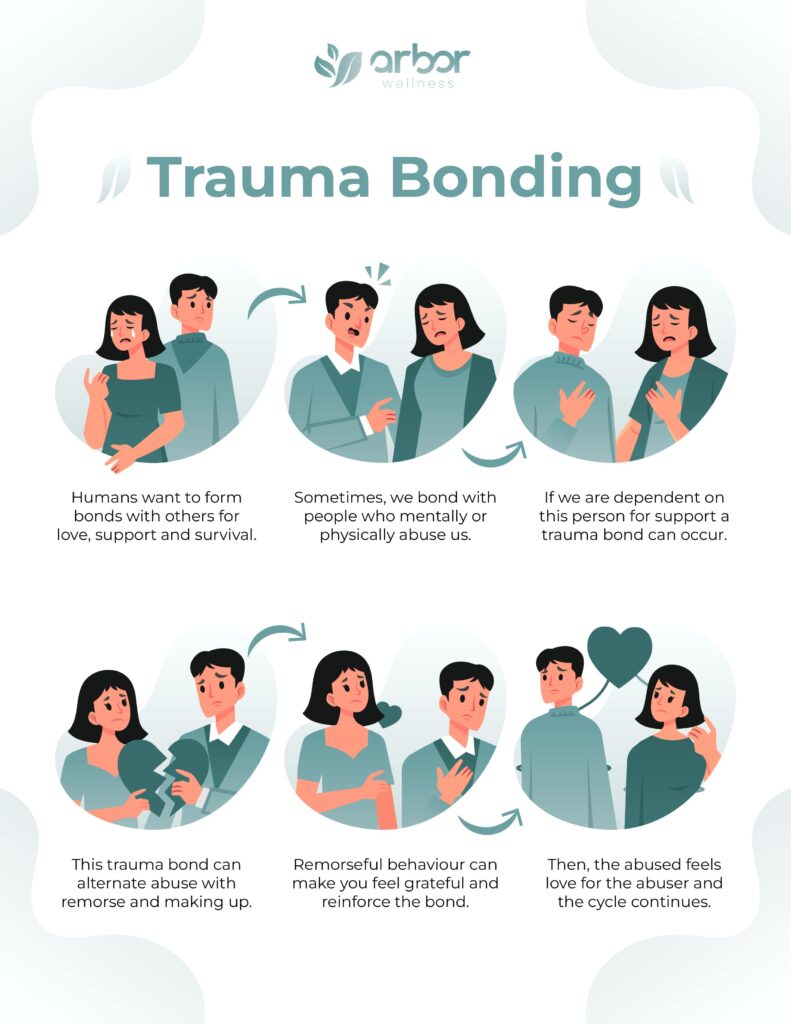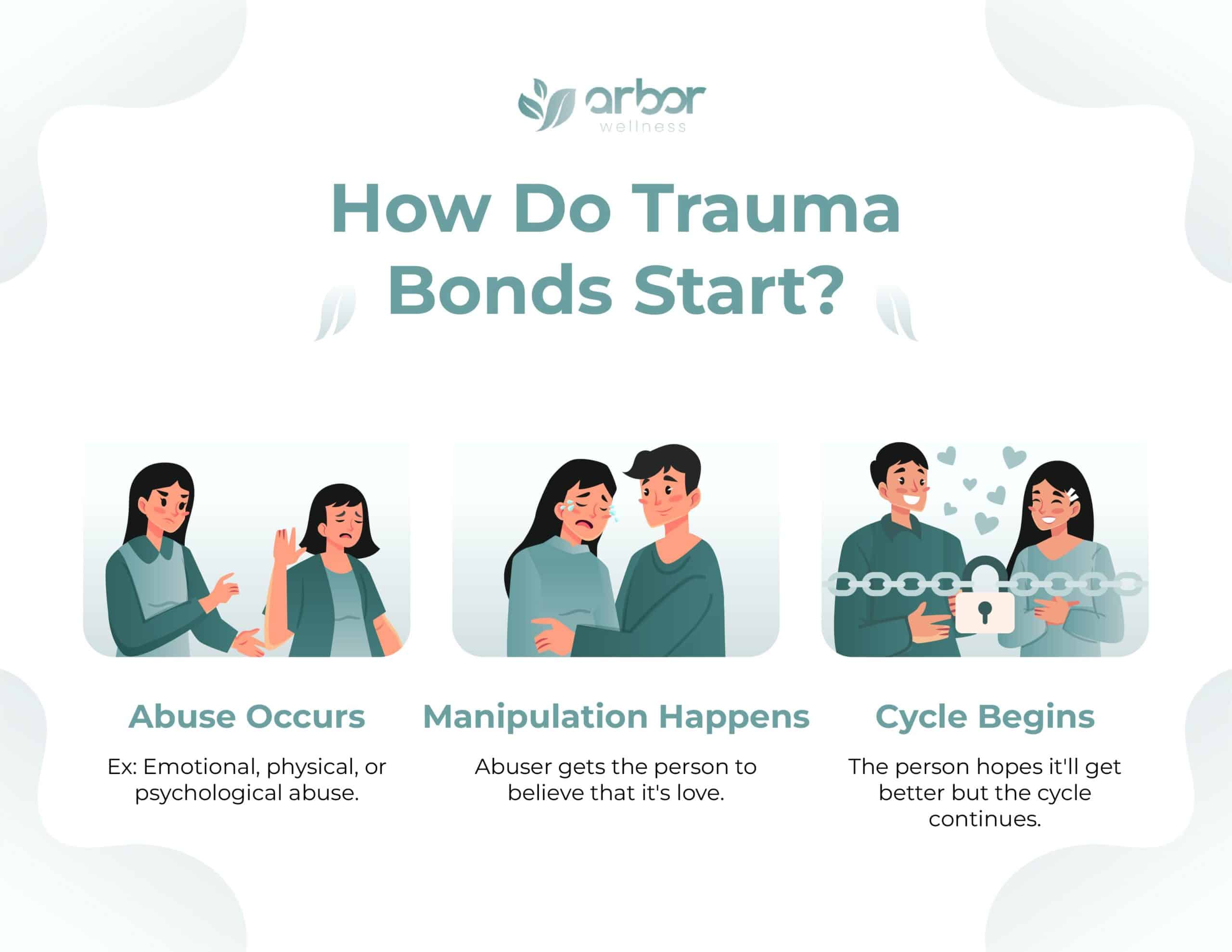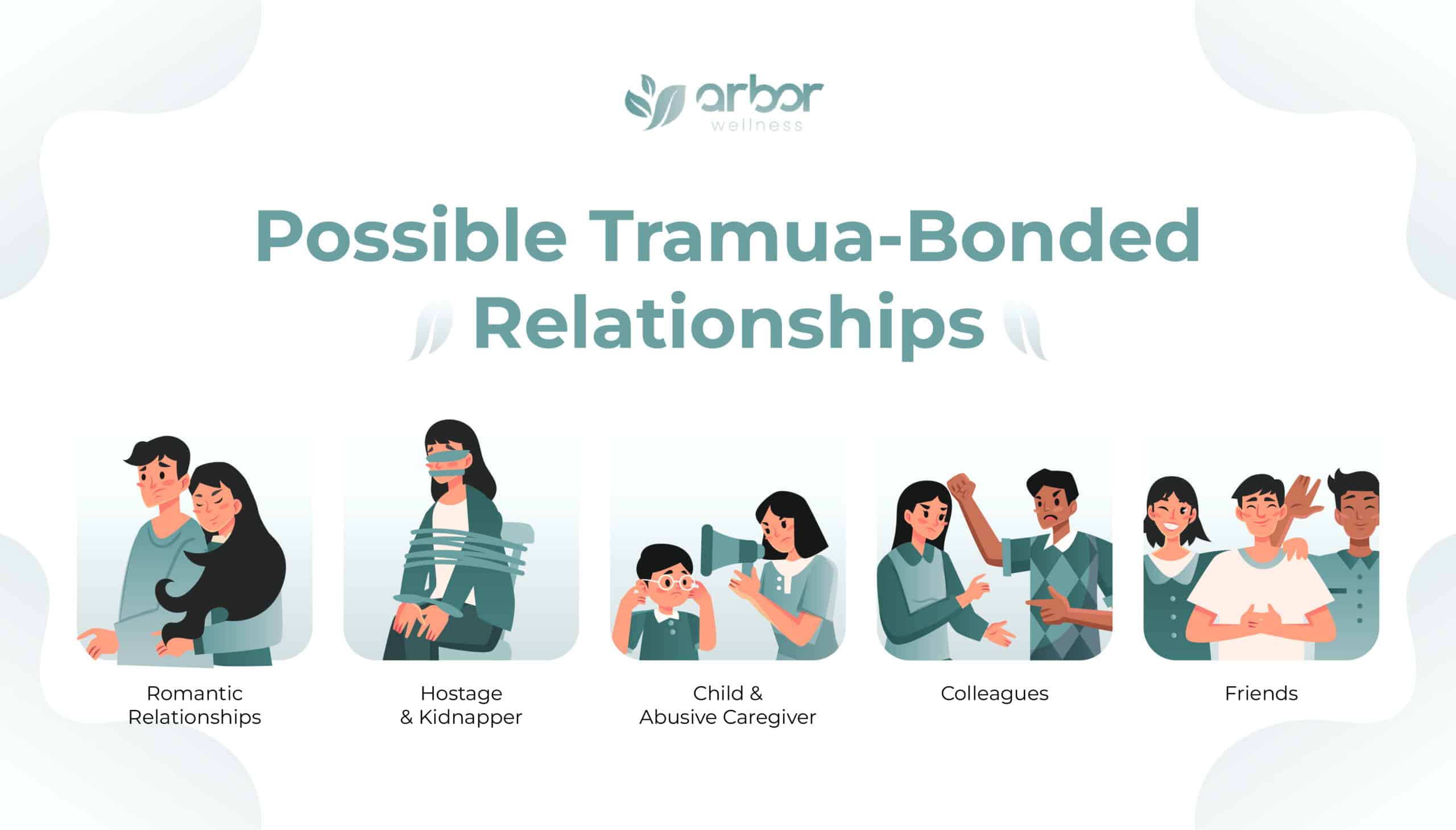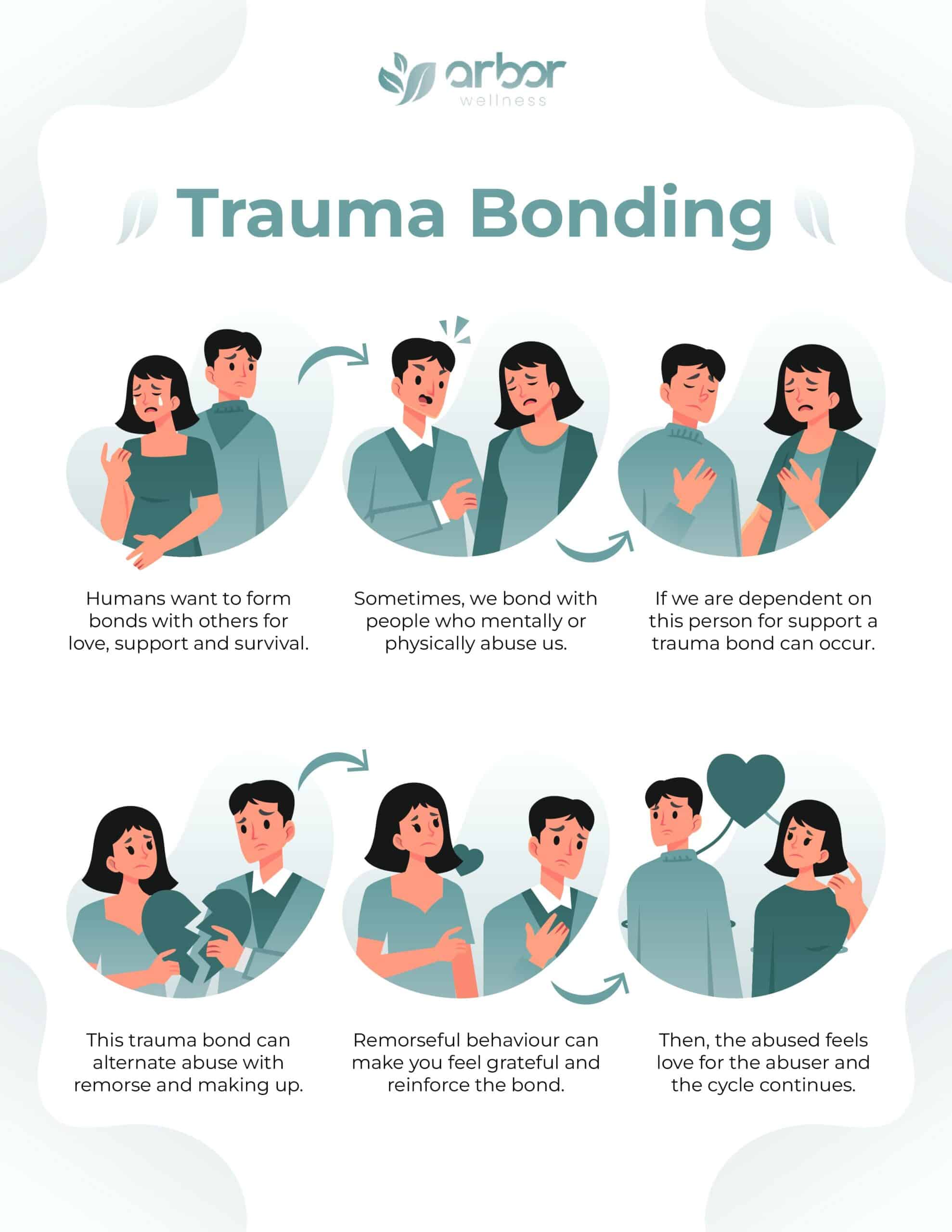Trauma bonding is a psychological phenomenon where a person develops an emotional attachment to someone who is destructive, abusive, or harmful to them. This seemingly paradoxical connection can be intense and difficult to break, even when the affected person recognizes the relationship as unhealthy or dangerous.
At Arbor Wellness, we understand the complexity of trauma bonds and are committed to helping individuals recognize, understand, and ultimately break free from these harmful attachments through effective mental health treatment.
If you’re struggling with the effects of trauma or trauma bonding, call us now at 629-217-2658 or verify your insurance.
Whether you’re questioning your own relationship dynamics or supporting someone who may be experiencing a trauma bond, this information provides valuable insights into this complex PTSD psychological phenomenon.
What Is a Trauma Bond?
A trauma bond is a strong emotional attachment that forms between an individual and someone who intermittently harms, threatens, or intimidates them.
The bond develops through repeated cycles of abuse interspersed with intermittent reinforcement or reward. This pattern creates a powerful emotional dependency that can override rational thought and self-protective instincts.
Psychiatrist Patrick Carnes, who pioneered research in this area, defined trauma bonding as “the misuse of fear, excitement, sexual feelings, and sexual physiology to entangle another person.”
Trauma bonds develop out of survival responses and can be mistaken for love or loyalty, but they are actually rooted in fear, dependence, and confusion.

What Is a Trauma-Bonded Relationship?
A trauma-bonded relationship is characterized by a power imbalance where one person exercises control through various means including intimidation, manipulation, isolation, humiliation, and occasional acts of kindness or affection.
These relationships often follow predictable patterns:
- Alternating cruelty and kindness: The controlling partner switches between abusive behavior and apparent warmth or generosity.
- Isolation: The affected person becomes increasingly separated from support networks.
- Dependency: Financial, emotional, or psychological dependency is fostered and exploited.
- Justification: The affected person begins to rationalize or minimize harmful behaviors.
- Identity erosion: The affected person’s sense of self and boundaries become progressively weakened.
These relationships can occur in various contexts, including romantic partnerships, parent-child relationships, friendships, and even professional relationships or cults. The core dynamic remains consistent—a cycle of harm, control, and intermittent reward that creates a powerful psychological dependency.
How Does Trauma Bonding Work?
Trauma bonding works through several psychological and neurobiological factors:
1. Intermittent Reinforcement
One of the most powerful behavioral conditioning tools is intermittent reinforcement—unpredictable rewards following certain behaviors. When someone experiences unpredictable cycles of abuse followed by kindness or affection, the brain becomes highly responsive to the positive moments, creating a persistent hope for their return.
2. Biochemical Responses
The extreme highs and lows in abusive relationships trigger powerful biochemical responses:
- During abuse, stress hormones like cortisol and adrenaline flood the system.
- During reconciliation, pleasure chemicals like dopamine, oxytocin, and endorphins are released.
This biochemical rollercoaster creates a form of addiction to the relationship dynamic.
3. Survival Mechanisms
When faced with ongoing threat, the brain employs various survival strategies:
- Stockholm Syndrome: Identifying with and becoming attached to the source of danger as a survival mechanism.
- Cognitive dissonance: Developing beliefs that minimize or justify harmful behavior to reduce internal psychological conflict.
- Traumatic bonding: Forming attachment to the source of safety and danger when they are the same person.
4. Power Dynamics
The controlling partner typically employs various tactics to maintain power:
- Creating dependency
- Isolating the victim from support systems
- Eroding self-esteem and confidence
- Gaslighting and reality distortion
- Leveraging shame and self-blame
These dynamics work together to create a psychological trap that can be difficult to recognize from within, and even harder to escape.
How Does a Trauma Bond Start?
Trauma bonds typically develop gradually through several stages:
Initial Connection
The relationship often begins with an intense connection characterized by:
- Excessive attention and affection (love bombing)
- Mirroring the other person’s values, interests, and desires
- Creating a sense of being “perfect” for each other
- Moving quickly into commitment or intimacy
Early Warning Signs
Subtle controlling behaviors may emerge, often disguised as care or concern:
- Possessiveness framed as devotion
- Isolation framed as wanting exclusive time together
- Criticism framed as helping
- Monitoring framed as interest
First Incidents
The first clearly abusive incidents are typically followed by:
- Extreme remorse and apologies
- Promises of change
- Heightened affection and gifts
- Explanations that minimize or justify the behavior
Normalization
Over time, harmful behaviors become normalized through:
- Gradual escalation of controlling or abusive behavior
- Increasing responsibility placed on the victim to prevent problems
- Growing isolation from external perspectives
- Erosion of boundaries and sense of self
Trauma bonds seldom form instantly but develop through repeated cycles of harm and reconciliation. The gradual nature of this process makes it difficult for individuals to recognize what’s happening until they are deeply entangled.

Why Is Trauma Bonding So Hard to Break?
Due to the cyclical cycle in trauma-bonded relationships, breaking a bond creates comes with numerous challenges that often require professional treatment and help:
Neurobiological Factors
- The relationship creates addiction-like patterns in the brain
- Withdrawal symptoms can occur when attempting to leave
- Stress responses become linked to attachment behaviors
Psychological Barriers
- Fear of the unknown or of retaliation
- Damaged self-esteem and confidence
- Learned helplessness
- Hope that things will improve
- Shame about the situation
Practical Obstacles
- Financial dependence
- Housing insecurity
- Co-parenting complications
- Lack of social support
- Fear for safety
Identity Factors
- Loss of sense of self
- Difficulty imagining life outside the relationship
- Identity formed around caretaking or fixing the relationship
These factors combine to create powerful resistance to change, even when the affected person intellectually understands the harmful nature of the relationship. Breaking free typically requires multiple attempts and comprehensive support.
Is Trauma Bonding Toxic?
Yes, trauma bonding is fundamentally unhealthy and toxic.
While the bond itself is a natural psychological response to a difficult situation, the relationship dynamic that creates and maintains the bond is inherently harmful.
Trauma bonds:
- Erode self-worth and autonomy
- Create persistent psychological distress
- Can lead to depression, anxiety, and PTSD
- May cause physical health problems due to chronic stress
- Prevent healthy relationship development
- Can escalate to increasingly dangerous situations
It’s important to understand that being in a trauma bond doesn’t indicate weakness or poor judgment. These attachments form through powerful psychological mechanisms that can affect anyone under the right circumstances. Recognizing a trauma bond as toxic is an important first step toward healing.
The 7 Stages of Trauma Bonding
Trauma bonding typically progresses through seven predictable stages:
1. Love Bombing
The relationship begins with overwhelming positive attention, affection, and seeming perfection.
The controlling partner may:
- Shower the other with compliments and gifts
- Seem perfectly attuned to their needs and desires
- Create a sense of being “soulmates” or having a unique connection
- Move very quickly toward commitment
2. Trust and Dependency
The foundation of trust is established, along with increasing dependency:
- The affected person begins to rely on their partner emotionally, practically, or financially
- Isolation from other support systems begins
- Boundaries start to erode
- A sense of merged identity may develop
3. Criticism and Abuse
Harmful behaviors emerge or escalate:
- Verbal, emotional, physical, or sexual abuse occurs
- Criticism becomes more frequent and severe
- Control tactics intensify
- Gaslighting may be employed to distort reality
4. Breaking Point and Rejection
A significant incident or period of rejection occurs:
- The controlling partner may threaten abandonment
- They may become cold, distant, or openly hostile
- The affected person experiences intense fear and distress
- A sense of doing anything to repair the relationship develops
5. Reconciliation and Relief
The controlling partner offers reconciliation:
- Apologies and promises of change
- Renewed affection and attention
- Possible explanations that shift blame
- The affected person experiences profound relief and hope
6. Calm and Maintenance
A period of relative calm follows:
- Tension gradually rebuilds
- The affected person walks on eggshells to maintain peace
- Hope that the relationship has permanently improved
- Rationalization of previous incidents
7. Cycle Repetition
The cycle begins again, typically with escalating intensity:
- Periods of calm become shorter
- Abusive incidents become more severe
- The psychological hold strengthens
- Breaking free becomes increasingly difficult
Understanding these stages can help individuals recognize patterns in their own relationships and identify appropriate intervention points.
What Is the Trauma Bonding Cycle?
The trauma bonding cycle is the repeated pattern of behavior that reinforces and strengthens the traumatic attachment.
This cycle typically includes:
Tension Building
- Increasing stress and anxiety
- Minor incidents that signal coming problems
- Walking on eggshells to prevent escalation
- Growing fear and hypervigilance
Incident
- Abusive behavior occurs (verbal, emotional, physical, sexual, financial)
- Control is exerted
- Boundaries are violated
- Fear, pain, and confusion result
Reconciliation
- Apologies and remorse (sometimes)
- Promises of change
- Explanations that minimize the incident
- Gifts, affection, or special treatment
Calm
- Period of relative peace
- Hope that problems are resolved
- Relief and attempt to return to normalcy
- Gradual return to tension building
This cycle can vary in duration—some cycles may complete within hours, while others might span weeks or months. Over time, the cycle typically accelerates, with shorter periods of calm and reconciliation and more frequent or severe incidents.
The predictable nature of this cycle creates a false sense of control for the affected person, who may believe they can prevent incidents by changing their own behavior. This illusion of control contributes to staying in the relationship despite ongoing harm.
Signs of Emotional Addiction
Trauma bonding creates patterns similar to addiction. Signs of emotional addiction in a relationship include:
Obsessive Thinking
- Constant preoccupation with the relationship
- Inability to focus on other aspects of life
- Intrusive thoughts about the partner
- Excessive time spent analyzing interactions
Withdrawal Symptoms
- Intense distress when separated
- Physical symptoms like nausea, insomnia, or panic when attempting to leave
- Overwhelming urge to return or make contact
- Relief upon reconnection regardless of circumstances
Prioritizing the Relationship Above All Else
- Neglecting self-care, work, or other responsibilities
- Sacrificing other relationships
- Abandoning personal values or boundaries
- Making increasingly harmful compromises
Failed Attempts to Leave
- Multiple unsuccessful attempts to end the relationship
- Returning despite promises to oneself or others
- Increasing isolation with each attempt
- Growing sense of helplessness
Diminishing Returns
- Needing more intense interactions to feel satisfaction
- Brief periods of happiness followed by longer periods of distress
- Declining overall wellbeing despite moments of connection
- Increasing tolerance for harmful behavior
Recognizing these signs of emotional addiction can help individuals understand the hold a trauma bond has on them and seek appropriate support for recovery.
Trauma Bonding Signs and Symptoms
Identifying trauma bonding can be challenging, especially from within the relationship.
Common signs and symptoms include:
Behavioral Signs
- Making excuses for a partner’s harmful behavior
- Hiding relationship problems from friends and family
- Defending the partner when others express concern
- Feeling unable to leave despite recognizing problems
- Seeking constant approval or validation from the partner
Emotional Symptoms
- Persistent shame, anxiety, or confusion
- Feeling responsible for the partner’s emotions or actions
- Emotional numbness alternating with intense feelings
- Relief when things are momentarily better
- Fear of abandonment or being alone
Cognitive Patterns
- Difficulty making decisions without the partner’s input
- Doubting one’s own perceptions or memories
- Minimizing or denying harmful incidents
- Black-and-white thinking about the relationship
- Persistent hope despite evidence against improvement
Physical Symptoms
- Stress-related health problems
- Sleep disturbances
- Changes in appetite
- Hypervigilance and startle responses
- Fatigue and low energy
Relational Patterns
- Isolation from support systems
- Changing behaviors to please the partner
- Accepting increasingly harmful treatment
- Feeling trapped but unable to leave
- Intense attachment despite ongoing harm
These signs and symptoms may vary in intensity and combination, but they generally point to an unhealthy attachment that prioritizes the relationship over personal wellbeing and reality.
If you are experiencing domestic violence, you can call the National Domestic Violence Hotline at 1-800-799-7233 or text “START” to 88788.
Trauma Bond vs. Love
Distinguishing between a trauma bond and healthy love is essential for relationship wellness.
Key differences include:
Foundation
- Trauma Bond: Based on fear, insecurity, and power imbalance
- Healthy Love: Based on mutual respect, trust, and genuine care
Freedom vs. Control
- Trauma Bond: Characterized by control, possession, and restriction
- Healthy Love: Supports independence, growth, and personal autonomy
Consistency vs. Volatility
- Trauma Bond: Features dramatic highs and lows, unpredictability
- Healthy Love: Provides consistent support and stable emotional climate
Effect on Self-Worth
- Trauma Bond: Erodes confidence and sense of self over time
- Healthy Love: Enhances self-esteem and encourages authenticity
Conflict Patterns
- Trauma Bond: Conflicts lead to power struggles, blame, and shame
- Healthy Love: Conflicts are addressed with respect and mutual problem-solving
Future Orientation
- Trauma Bond: Creates anxiety about the future and fear of abandonment
- Healthy Love: Builds security and positive anticipation of shared future
Growth Direction
- Trauma Bond: Partners become increasingly dependent and isolated
- Healthy Love: Partners grow individually and as a couple
Recognizing these distinctions can help individuals evaluate their relationships more objectively and identify concerning patterns that may indicate trauma bonding rather than healthy attachment.
What Happens to the Brain in a Trauma Bond?
Trauma bonding creates significant neurobiological changes:
Stress Response System
- The body’s stress response system becomes chronically activated
- Cortisol and adrenaline are frequently elevated
- This creates a state of hypervigilance and heightened reactivity
- Over time, this can lead to disregulation of the entire stress response system
Reward Pathways
- The dopamine reward system becomes activated during reconciliation phases
- The contrast between stress and relief creates powerful reinforcement
- This establishes addiction-like patterns in the brain’s reward circuitry
- The relationship becomes associated with both danger and relief
Attachment Systems
- The brain’s attachment systems become linked with fear responses
- Oxytocin (the “bonding hormone”) is released during reconciliation
- This creates confusion between love and fear at a neurochemical level
- Attachment becomes stronger despite—or even because of—the harmful dynamics
Cognitive Processing
- Continued stress affects the prefrontal cortex, responsible for decision-making
- This impairs rational evaluation of the relationship
- Emotional processing takes precedence over logical assessment
- Trauma responses can trigger dissociation or emotional numbing
Memory Formation
- Traumatic experiences affect memory processing
- The brain may compartmentalize negative experiences
- Positive moments may be disproportionately emphasized
- This creates a distorted perception of the relationship’s overall quality
These neurobiological changes explain why trauma bonds can feel so compelling despite their harmful nature.
Understanding these processes can help reduce shame and self-blame while highlighting the importance of professional support for recovery.
What Does a Trauma Bond Look Like in Relationships?
Trauma bonds manifest in various relationships with common patterns:
In Romantic Relationships
- Intense jealousy disguised as love
- Isolation from friends and family
- Financial control or exploitation
- Cycles of tension, incident, reconciliation, and calm
- Emotional manipulation and gaslighting
- Sexual coercion or using intimacy as control
- Threats of abandonment or harm if the relationship ends
In Parent-Child Relationships
- Unpredictable parenting with extreme discipline and occasional indulgence
- Child becoming responsible for parent’s emotional state
- Child developing caretaking role (“parentification”)
- Child defending abusive parent to others
- Child unable to separate despite ongoing harm into adulthood
- Adult child experiencing guilt when establishing boundaries
In Friendships
- One-sided dynamics where one person gives and the other takes
- Friend creating crises that require rescue
- Alternating excessive flattery with criticism
- Using secrets or personal information as leverage
- Creating competition or triangulation with other friends
- Punishing through silent treatment or emotional withdrawal
In Professional Relationships
- Boss or mentor who alternates between praise and humiliation
- Creating dependencies through promises of advancement
- Using power differential to demand inappropriate loyalty
- Taking credit for work while blaming others for failures
- Creating an environment where employees compete for approval
- Retaliation against those who set boundaries or leave
These patterns may vary in intensity and specific manifestation, but the underlying dynamic remains consistent: intermittent reinforcement, power imbalance, and the formation of attachment through cycles of harm and reconciliation.

How Do I Break a Trauma Bond?
Breaking a trauma bond is challenging but possible with the right approach:
Safety Planning
- Assess any physical danger and create a safety plan
- Secure important documents and financial resources
- Identify safe places to go if needed
- Connect with domestic violence resources if applicable
- Consider legal protections if necessary
Education and Awareness
- Learn about trauma bonding mechanisms
- Recognize the patterns in your specific situation
- Understand that your attachment is a normal response to abnormal circumstances
- Educate yourself about healthy relationship dynamics
- Acknowledge the reality of the situation without judgment
Support System
- Reconnect with friends and family when safe to do so
- Join a mental health support group for shared understanding
- Work with a trauma-informed therapist
- Consider temporary additional support during the initial separation
- Create a communication plan with trusted individuals
Practical Steps
- Limit or eliminate contact when possible
- Block communication channels to reduce temptation
- Remove reminders and triggers from your environment
- Create new routines and habits
- Develop structure for difficult times
Self-Care Practices
- Establish consistent sleep and eating patterns
- Engage in regular physical activity
- Practice grounding techniques for emotional regulation
- Maintain a journal to process feelings and recognize patterns
- Set small, achievable goals to rebuild confidence
Breaking a trauma bond typically involves periods of progress and setbacks. Each attempt builds strength and clarity, even when it doesn’t immediately result in permanent separation. Compassion for oneself throughout this process is essential.
How Do I Know If I’m in a Trauma Bond?
Self-assessment questions to help identify a potential trauma bond:
Relationship Dynamics
- Do you feel both intense love and fear toward your partner?
- Does the relationship cycle between conflict and passionate reconciliation?
- Do you find yourself walking on eggshells to avoid triggering problems?
- Have friends or family expressed concern about your relationship?
- Do you feel you must hide aspects of your relationship from others?
Personal Experience
- Has your self-confidence decreased since beginning this relationship?
- Do you feel responsible for your partner’s emotions or behavior?
- Have you lost interest in activities or relationships you once valued?
- Do you feel unable to leave despite recognizing harmful patterns?
- Do you frequently doubt your own perceptions or memories?
Behavioral Patterns
- Do you make excuses for your partner’s behavior toward you?
- Have you tried to leave multiple times but returned?
- Do you experience intense distress when separated from your partner?
- Have you compromised important values or boundaries to maintain the relationship?
- Do you feel your primary identity is now tied to the relationship?
Emotional Indicators
- Do you experience relief when your partner is temporarily kind after being hurtful?
- Do you feel shame about staying in the relationship?
- Are you constantly anxious about the relationship status?
- Do you feel both trapped and afraid of the relationship ending?
- Have you lost touch with how you actually feel most of the time?
If you answered yes to several of these questions, you may be experiencing a trauma bond.
Remember that recognizing this pattern is an important first step toward healing.
Can a Trauma Bond Cause Physical Withdrawal Symptoms?
Yes, trauma bonds can cause genuine physical withdrawal symptoms due to their neurobiological impact.
Withdrawal symptoms include:
Neurochemical Basis
- The sudden absence of relationship-related neurochemicals (dopamine, oxytocin, adrenaline) creates physical withdrawal
- The body has adapted to cycles of stress and relief
- Breaking this pattern creates physical dysregulation
Common Physical Symptoms
- Nausea and digestive disturbances
- Trembling or shaking
- Heart palpitations
- Dizziness or lightheadedness
- Chest tightness or pain
- Difficulty breathing
- Muscle aches and pains
- Fatigue despite insomnia
- Hypersensitivity to stimuli
Duration and Intensity
- Physical symptoms are typically most intense in the first 1-2 weeks
- Symptoms may come in waves rather than constant presence
- Physical intensity generally decreases before emotional attachment does
- Certain triggers may cause temporary return of symptoms even months later
These physical symptoms are real physiological responses, not weakness or imagination. Understanding their basis can help in developing appropriate coping strategies and seeking proper support during the withdrawal period.
What Does Emotional Withdrawal Look Like?
Emotional withdrawal from a trauma bond involves several distinct phases:
Initial Crisis Phase (Days 1-14)
- Overwhelming emotional pain
- Feeling as if you cannot survive without the person
- Desperate urge to reconcile regardless of consequences
- Difficulty functioning in daily activities
- Emotional numbness alternating with intense grief
- Disorientation and confusion
Cognitive Dissonance Phase (Weeks 2-8)
- Alternating between idealizing and vilifying the former partner
- Ruminating about the relationship—both good and bad times
- Questioning your decision to leave
- Struggling to form a coherent narrative about the relationship
- Memory issues including intrusive flashbacks
- Difficulty concentrating on other aspects of life
Grief and Processing Phase (Months 2-6)
- Sadness about the relationship loss
- Anger about the harm experienced
- Fear about the future
- Shame about staying as long as you did
- Grief for the relationship you wished you had
- Beginning to integrate the experience into your life story
Rebuilding Phase (Months 6+)
- Rediscovering personal interests and values
- Establishing new routines and habits
- Developing healthier relationship patterns
- Experiencing longer periods of emotional stability
- Finding meaning in the experience
- Cautious hope for the future
This timeline varies considerably based on relationship duration, trauma severity, support availability, and individual factors. The process is rarely linear, with progress often following a “two steps forward, one step back” pattern.
How to Heal from Trauma Bonding?
Healing from trauma bonding is a multifaceted process:
Stage 1: Safety and Stabilization
- Establish physical safety through separation when possible
- Create emotional safety through boundaries and support
- Develop grounding techniques for managing intense emotions
- Stabilize daily routines including sleep, nutrition, and basic self-care
- Learn to identify and name feelings as they arise
Stage 2: Processing the Experience
- Work through cognitive distortions about the relationship
- Identify patterns that contributed to vulnerability
- Process grief for both the relationship and its impact
- Address shame and self-blame with compassion
- Recognize the strength it took to survive and eventually leave
Stage 3: Reconnection with Self
- Rediscover personal values, preferences, and boundaries
- Rebuild confidence through small successes
- Reclaim aspects of identity that were compromised
- Develop healthy self-relationship through self-compassion
- Establish internal validation rather than seeking external approval
Stage 4: Creating New Patterns
- Practice new relationship skills in safe contexts
- Learn to recognize healthy versus unhealthy relationship dynamics
- Develop trust in your own perceptions and judgments
- Build meaningful connections based on mutual respect
- Create a life with purpose beyond relationships
Throughout this process, patience and self-compassion are essential. Healing is not linear, and temporary setbacks are normal parts of the journey. Each person’s healing timeline is unique, and comparing progress to others is rarely helpful.
How Is Trauma Bonding Treated?
Professional treatment for trauma bonding typically includes several approaches:
Trauma-Focused Therapy
- EMDR (Eye Movement Desensitization and Reprocessing): Helps process traumatic memories and reduce their emotional charge
- CPT (Cognitive Processing Therapy): Addresses distorted beliefs related to trauma
- Somatic Experiencing: Works with body-based trauma responses
- Internal Family Systems: Addresses different “parts” that developed to cope with trauma
Cognitive-Behavioral Approaches
- CBT (Cognitive Behavioral Therapy): Identifies and changes unhelpful thought patterns
- DBT (Dialectical Behavior Therapy): Develops emotional regulation and distress tolerance
- Schema Therapy: Addresses early maladaptive patterns that contribute to vulnerability
Relational Healing
- Group Therapy: Provides shared understanding and reduces isolation
- Attachment-Focused Therapy: Works to create new, healthy attachment patterns
- Family Systems Therapy: Addresses broader relationship dynamics when appropriate
Complementary Approaches
- Medication: May help manage symptoms of depression, anxiety, or PTSD
- Body-Based Practices: Yoga, tai chi, or other approaches that address the physical aspects of trauma
- Expressive Therapies: Art, music, or movement therapies that access trauma through non-verbal means
- Mindfulness Practices: Developing present-moment awareness and compassionate observation
Treatment is typically most effective when tailored to the individual’s specific needs, history, and preferences. A comprehensive approach that addresses both the psychological and physiological aspects of trauma bonding tends to be most successful.
Can Therapy Help Trauma Bonding?
Yes, therapy can be tremendously beneficial for healing from trauma bonding:
Benefits of Professional Support
- Objective Perspective: Therapists can help identify patterns that may be difficult to recognize from within
- Validation: Understanding that trauma bonding is a normal response to abnormal circumstances
- Safety: Providing a secure space to process difficult emotions without judgment
- Expertise: Guidance from someone trained in trauma and attachment dynamics
- Accountability: Support in maintaining boundaries and progress through difficult periods
Choosing the Right Therapist
When seeking therapy for trauma bonding, look for:
- Training and experience in trauma, particularly interpersonal trauma
- Understanding of domestic violence dynamics when applicable
- Approach that balances validation with gentle challenging
- Comfort with both emotional processing and practical skill-building
- Cultural competence relevant to your background and experience
Preparing for Therapy
To make the most of therapeutic support:
- Be honest about your experiences, even those that feel shameful
- Recognize that healing takes time and is rarely linear
- Commit to attending sessions even when difficult
- Practice new skills between sessions
- Consider therapy as one part of a broader healing approach
Many people find that the therapeutic relationship itself provides a corrective emotional experience—a relationship where boundaries are respected, emotions are validated, and personal growth is encouraged.
Find Help For Your Mental Health Today
At Arbor Wellness, we understand the complex journey of healing from trauma bonds. If you recognize patterns of trauma bonding in your own life or in someone you care about, know that recovery is possible with the right support.
Our team of trauma-informed therapists specializes in helping individuals understand, address, and heal from traumatic attachments. We offer compassionate guidance through each stage of the recovery process, from initial safety planning to developing new patterns for healthy relationships with residential and outpatient mental health treatment programs.
No matter how long you’ve been in a trauma bond or how many times you’ve tried to leave, healing is possible. Reach out today to begin your journey toward freedom and renewal.
Call us now at 629-217-2658 or verify your insurance now.
This article is for informational purposes only and does not constitute medical advice. If you are in immediate danger, please call 911 or your local emergency services. For domestic violence support, the National Domestic Violence Hotline is available 24/7 at 1-800-799-7233.

























